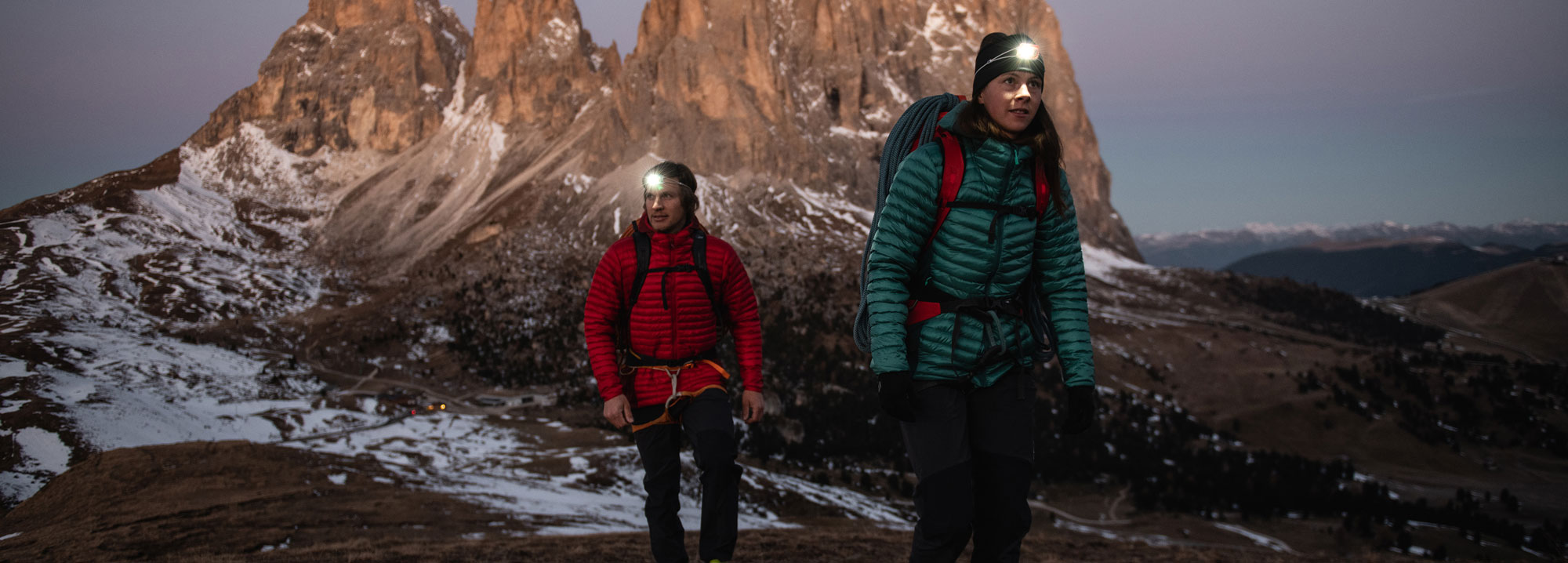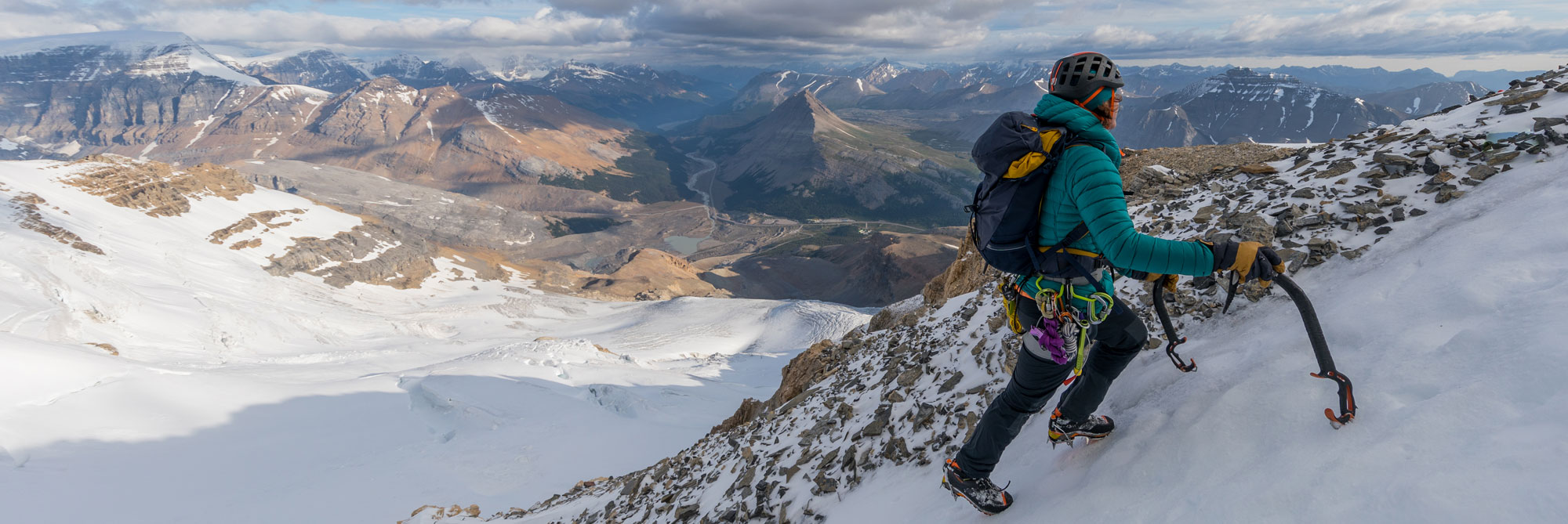The Ultimate Guide to Choosing an Ultralight Down Jacket
May 24, 2022

Down is still the number one insulating material in the outdoor industry, offering the lightest warmth to weight ratio and unrivaled packability. Therefore, a down jacket will provide exceptional warmth but won't weigh you or your pack down. Choosing a down jacket depends on how warm you need it to be and what features you need it to have.
How Warm Should It Be?
Our lightest down jackets weigh less than 150 grams and will be as warm as a microfleece that is three times the weight. Heavier down jackets around 350-500 grams are equivalent to very heavyweight fleeces in terms of warmth and are ideal mid layers. Beyond this weight there are jackets weighing 500 grams + which are outer garments for very cold conditions. Therefore, when comparing the warmth of jackets, there are some factors to consider.
Down Quality
Generally the more down in a jacket (fill weight), the warmer it is going to be but this assumes the down is the same quality. However, down quality can vary significantly and is measured by its fill power. A higher fill power down will keep you warmer than a lower fill power. To make matters worse there are two widely recognised methods of measuring Fill Power - the 'US' Method and the 'EU' Method. Both methods work on the same methodology but the 'US' Method gives a slightly higher figure than the 'EU' Method for the same quality down - so an 800+ Fill Power (EU Method) is approximately equivalent to an 850+ Fill Power (US Method).
Wherever we quote a Fill Power for a specific garment (or sleeping bag) we specify that the measurement is either 'EU' or 'US' method - so that you can be sure of the facts. Because the difference is small, and for simplicity, when writing in general - such as for this article - we won't make the distinction. So, as a general rule then:
- 650 fill power is considered to be a high quality down for outdoor gear.
- 750-850 fill power is considered to be in the upper bracket in terms of down quality.
- 900+ fill power is even higher quality again but is expensive, resulting in higher priced garments.

Which Features are Important?
Down jackets can be fairly minimal with regards to features compared to some other types of jackets. However, it is important to select a down jacket that has the features you need and leaving out any features that aren't essential will help save weight.
Hood or no Hood?
Whether or not you need a hood is down to personal preference and whether you will be using the jacket as a midlayer or an outer layer. If the jacket will be used as a midlayer, a hood may not be needed because it could result in 'hood overload' if additional layers are going to be worn over the top of it - and they all have hoods as well!
Pockets?
While pockets may not be essential on down jackets, most will have two hip pockets, while some offer an additional chest pocket. Consider what you will be using the jacket for (e.g. will it be used as an outer or a midlayer) and choose one with pockets accordingly. Remember, unnecessary pockets will add unwanted weight.
If the jacket is going to be used as an outer layer then more pockets may be needed as you are likely to store things in these that you will need easy access to through the day/night and you should also consider the position of these pockets, especially the hand warmer pockets on the hip - these should be big and in a comfortable position.
Zips are a consideration as well - some jackets will have 'open pockets' whereas others will have zip closures - we think zip closures are better for down jackets because open pockets allow cold winds in and warm air out - you need to be able to close the pocket to maximise the insulation of the jacket. Although zips on pockets add weight to the jacket.
Box-Wall vs Stitch-Through Construction
Down jackets can either have box-wall or stitch-through construction. Horizontal box-wall construction is the warmer of the two, as it utilises the loft and warmth of the down more effectively, resulting in less cold spots. These horizontal compartments are designed to hold the down in place around the body and maximize the performance of the jacket - jackets using this method are quite often heavier and don't pack down as small as most jackets that use smaller stitch-through construction due to more material being used.
Stitch-through construction is the more common approach as it is easier and less time-consuming to produce for manufacturers; the outer material is stitched directly into the inner lining, separating the down in different baffles but this is less warm than box-wall because the down is pinched at the seams, reducing the optimum loft of the down, which can create cold spots. This method uses less fabric and is lighter than more complicated box baffle construction, therefore it is often cheaper for consumers.
As you can imagine making fabric 'boxes' for the down rather than sewing through quilt style is a lot more work and is a lot more complicated to make. For this reason most jackets are 'stitch through' and the few that are 'Box-Wall' are more expensive.

Hydrophobic Down
When down gets wet, it will lose most of its insulation properties but this is where Hydrophobic down comes in - this is a relatively new concept and the purpose is to solve the main drawback of 'regular' down, which is it's lack of effectiveness when wet. Hydrophobic down has been treated with a durable water repellent that enables the down to dry quicker and resist water for longer, meaning it will perform better in damp conditions. This makes down jackets that utilise hydrophobic down more versatile, as they can be used in cold, damp conditions without being damaged, which is great for the British climate.
Jackets using hydrophobic down tend to be slightly more expensive, as it is another process and expense for the manufacturer. Whether or not you need hydrophobic down depends on personal preference and whether you feel this is a feature you need, although more and more manufacturers are using hydrophobic down in their products.
There are many more features that down jacket manufacturers may or may not integrate in to their products but the above are what we see as the core features that should be taken in to consideration. Other features that you may want to consider are draught exclusions, zip protection, effectiveness of the collar, cuffs and adjustable hems.
Tips & Care
Drying your Down Jacket
As mentioned previously, you should try to avoid getting your down jacket wet but sometimes this is inevitable. If it does get wet, down jackets should be dried flat, not hung, otherwise this may damage the internal baffles as the filling becomes heavy when wet. They can also be tumble-dried on a low heat setting but it may be worth noting that putting something like a tennis ball in with it will help break up any clumps of down that may have formed when it got wet. They should be washed in natural soaps or using specialist washes from companies such as Nikwax, which are specially designed for the job.
Storing your Down Jacket
If you're putting your down jacket away for an extended period of time i.e. throughout summer, it should be hung up so that the down isn't compressed, as this can damage the fill of the down and where it is stored should also be dry. Down jackets should not be stored in their compression sacks for long periods of time.
Summary
To summarise, down jackets are great for cold conditions and they are the pinnacle of insulation when it comes to warmth-to-weight ratio compared to other alternatives, such as synthetic insulation. When choosing a down jacket, there are a number of points to take in to account, which have been outlined above but how warm you need to jacket to be and whether you will be using it as a mid or outer-layer should be the two main consideration

